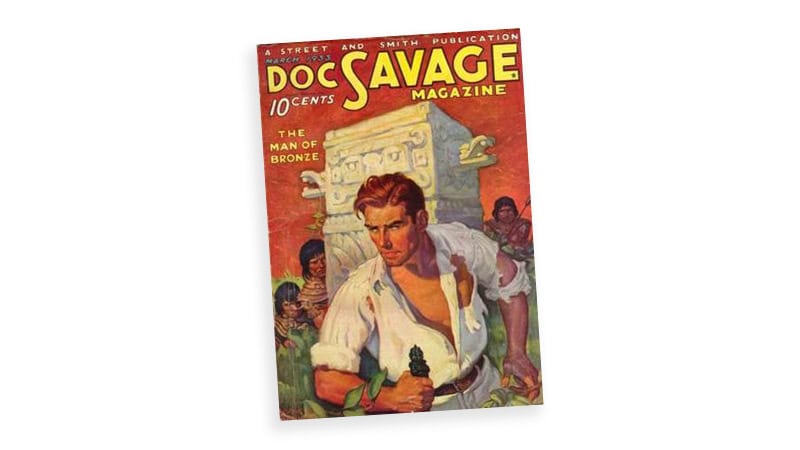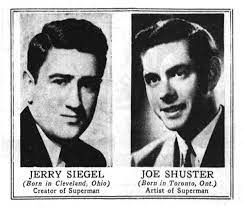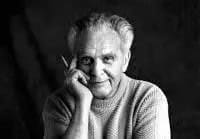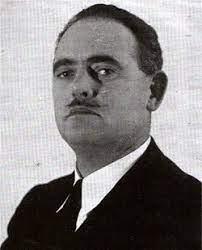Doc Savage: Innovations and Inspirations
How the character influenced the comic book industry

Writer David Gallery examines the innovations of the character Doc Savage and how those innovations influenced the comic book industry, from characters that followed in his footsteps to the superhero gadgets they used.
QUESTION: What do the creators of Batman, Superman, and Captain America all have in common?
ANSWER: It has been reported that they borrowed or copied various ideas and creations from the Doc Savage stories and incorporated them into their own works.
Just in case or for those who may not know, let’s answer the question, who is Doc Savage?
Doc Savage is a fictional character (created by Lester Dent) of the capable man hero type, who first appeared in American pulp magazines during the 1930s and 1940s. His given name was Clark Savage Jr., his occupations varied from a brilliant scientist, explorer, and detective, to a warrior who “rights wrongs and punishes evildoers.” Savage was raised to be the perfect man, a skilled surgeon and a master of a myriad of other scientific disciplines. He endured intensive training and daily two-hour exercise regimens and possessed strength, speed, stamina, and reflexes that bordered on superhuman. Even in this 21st century, Doc Savage has remained a nostalgic icon.
Longtime Marvel Comics editor Stan Lee credited Doc Savage for being the forerunner to modern superheroes.
Some commonalities between Doc Savage and other superheroes
The Fortress of Solitude
The Fortress of Solitude first appeared in Doc Savage’s book published in October 1938. Then it appeared in Superman’s Action Comics #241 (June 1958).

Superman, from the planet Krypton, is an American superhero who appears in stories published by the Action/DC Comics Company. The character was created by writer Jerry Siegel and artist Joe Shuster. He made his debut in Action Comics #1 (cover dated June 1938 and published April 18, 1938).
The Fortress of Solitude is a fictional stronghold commonly associated with Superman. It is where he first learned about his true identity, heritage, and purpose on Earth. It functions as a place of solace and his occasional headquarters. Described as being located in a frozen tundra, away from civilization, traditionally the fort is located in the Arctic.
Although Superman has living quarters there, his main residence is still at Clark Kent’s apartment in Metropolis. The Arctic bastion concept was originally created for pulp hero Doc Savage’s books published during the 1930s and 1940s. Doc built his stronghold in the Arctic and often retreated to it alone to make new scientific or medical breakthroughs to store dangerous technology and other secrets.
The Red Skull
A Doc Savage book titled “The Red Skull” was published in 1933. Stan Lee utilized that same name in Captain America versus the Red Skull, this villain who remained as his archenemy over the years.

Captain America is the superhero created by Joe Simon and Jack Kirby who appears in stories published by Timely and Marvel Comics. The character first appeared in Captain America Comics #1, published on December 20, 1940, by Timely Comics.
Steve Rogers was a would be U.S. Army enlistee rejected by recruiters because of his slender, bony size. He volunteers to receive a top secret serum from a military department that transforms him into a “super soldier.” Now dubbed Captain America, he is outfitted in a red, white, and blue costume and carries a matching indestructible stars and stripes shield.
The Red Skull (Johann Schmidt) is a super-villain depicted as a Nazi agent and protégée of Adolf Hitler during World War II. Although he initially wears a fearsome blood red skull mask, Schmidt suffers a horrific disfigurement decades later that causes his face to match his namesake.
The utility vest
Beginning in his first story in 1933 and every tale thereafter until the 1940s, Doc Savage, the bronze man (he was called the Man of Bronze because of his sun bronzed skin) wore a “utility vest.”
Doc’s leather vest had a bullet proof liner and featured a multitude of pouches. He carried dozens of gimmicks, everything from smoke bombs to anesthetic gas capsules. Often, he would develop one of his own wild inventions, like a powder that fluoresced when disturbed, which would illuminate fingerprints or footprints as glowing outlines. Or the chalk that left invisible marks that could only be seen through ultraviolet goggles. Sometimes he carried firecrackers, which when lit sounded like gunshots that could provide a distraction. Doc’s gadgets were a strong part of his appeal; they were creative and imaginative, showing writer Lester Dent’s own genuine love of contraptions.

Robert Kane (Oct. 24, 1915 to Nov. 3, 1998) was a comic book writer, animator, and artist who co-created Batman (with Bill Finger) along with many of the early DC Comic characters.
The utility belt is one of Batman’s most important tools in his ongoing pursuit of fighting crime. It consists primarily of a strap and buckle, which houses 10 pouches or cylindrical pockets that are attached to the outside. The buckle usually contains a miniature camera and a tape recorder. A secondary compartment behind the belt’s length houses Batman’s supply of batarangs, which basically is a bat shaped (like the flying mammal) throwing weapon. The name is a combination of the words bat and boomerang, and was originally spelled “batarang.”
Each of the ten pouches or cylinders holds various tools integral to Batman’s war on crime. Through the years, he has modified the contents of the belt to accommodate various crime fighting situations.
Most versions incorporate security features to prevent anyone other than Batman from opening it. It is designed to electrocute any villain who even touches it. Plus, it’s able to release stun gas to prevent tampering. The compartments are locked and only Batman knows how to open them.
Newer variations of Batman’s belt include sonic and flash grenades, tasers, small explosives, a knife, handcuffs, and even brass knuckles
It may also contain a first aid kit, lock picks, mace, flares, re-breather (to breath underwater), grappling line and hook, smoke bombs, flashlight, stun gun, listening device, several tools, and gas pellets.
Remembering the original Batwoman
Lester Dent’s influence on Stan Lee
Stan Lee, born Stanley Martin Lieber (Dec. 28, 1922 to Nov. 12, 2018), was an American comic book writer, editor, publisher, and producer.
He advanced up the ladder of Timely Comics, a family run business that later became Marvel Comics. Lee was the principal creative head for two decades, directing the company’s expansion from a small part of a publishing firm into a multimedia corporation that dominated the comics and film industries.
In collaboration with others at Marvel, particularly co writers and artists Jack Kirby and Steve Ditko, he co created a multitude of illustrious superheroes such as Spider Man, the X Men, Iron Man, Thor, the Hulk, Ant Man, the Wasp, the Fantastic Four, Black Panther, Daredevil, Doctor Strange, the Scarlet Witch, and Black Widow.
In 2006 Stan Lee stated that as a youth he was influenced by books such as Doc Savage and movies, particularly those with Errol Flynn playing heroic roles. Regarding “The Scarlet Pimpernel,” he called the title character “the first superhero I had read about, the first character who could be called a superhero.”
The man behind Doc Savage

Lester Dent (Oct. 12, 1904 to March 11, 1959) was a pulp fiction author, best known as the imaginative creator and principal writer for the series of novels about the scientist and adventurer Doc Savage.
In 1926 Dent was a telegraph operator for the Associated Press. A co worker of his had published a story in a pulp magazine, for which he was paid the huge sum (a lot of money for that time) of $450. Dent, a ravenous reader, was familiar with them and felt that he could learn the trade and possibly write better than some on the publications currently on the market.
In 1932, Henry Ralston of Street and Smith Publications contacted Dent with a proposition for a new magazine. He had in mind a new kind of action-adventure hero, which appealed to Dent’s love of that genre. Thus, the creation of the ingenious Doc Savage.
Issue Number #1 of the Doc Savage magazine hit the stands in February 1933; within six months it was one of the top sellers on the market. Much of the success stemmed from Dent’s fantastic imagination, fueled by his own personal curiosity.
Of the approximate 182 Doc Savage novels that Dent wrote over a 16-year period, only 10 of the early books were credited to Dent’s name. The others were ascribed to the publishing house’s fictitious author Kenneth Robeson.
While Dent was unhappy to discover that his stories would be published under the house name, Kenneth Robeson, he was more than happy to receive $500 per novel (which would later increase to $750 per book).
Lester Dent described the Doc Savage character as “possessing the mind of Sherlock Holmes, the strength of Tarzan and the goodness of Abraham Lincoln.”
The DC-Doc Savage connection
A fair amount has been written concerning the general influence of Doc Savage on the Superman character. This idea is nothing new and has been around for years. Jim Steranko says it best in “The History of Comics Volume 1.” Initially, Superman was a variation of pulp heavyweight Doc Savage. The concept and even the name Superman could easily have been inspired by a Street & Smith advertisement that ran in the early ’30 s pulps. Comparisons between Shuster’s original Superman drawing and Doc’s promotional ads bears marked similarities.
Was the TV Batgirl weakened and humiliated, unlike her comic book counterpart?
Was Doc Savage the original superhero?
Over the years in the pages of the Doc Savage magazines and books, he and his group of talented sidekicks fought a variety of master criminals, evil dictators, ruthless killers, and mad scientists.
Based in New York City, he worked out of his headquarters located on the 86th floor of an unnamed skyscraper, which is assumed by many fans to be the Empire State Building.
He used a variety of different vehicles during his exploits, but it is debated as to which ones he may have actually driven.
Additionally, there are many other creations credited to Lester Dent’s imagination. Telephone answering machines, goggles that enabled Doc to see at night, fully automatic machine pistols, and a flying air-wing were among the other items of technology that Doc Savage utilized in his adventures. The flying air-wing was a trimotor, low-wing aircraft, further described as a speed plane capable of cruising at 200 mph, which was considered fairly fast for the era. In the pre-war early 1930s stories, Doc Savage and his crew typically flew around the world in this vehicle.
During the 1930s to 1940s, known as the Golden Age of Radio, there aired a Doc Savage program. Unfortunately, none of the original recordings of that show exist today.
Feature image
Cover of Doc Savage Magazine – March 1933. Feature image credit: By Walter M. Baumhofer (Street & Smith) – The Internet, Fair use, https://en.wikipedia.org/w/index.php?curid’47112893
References
- Superman and Batman Were Modeled After One of the World’s First Superheroes, By Devon Lord Moncrief. Published May 20 2023, cbr.com: https://www.cbr.com/batman-superman-doc-savage-model/.
- Bronze Icon, The Doc Savage Stories: 1933 to 1949: https://bronzeicon.com.
- “Doc Savage His Apocalyptic Life: The complete story of the Man of Bronze, America’s Supreme Superhero!” by Philip Jose Farmer. Bantam Books, 1975.
- “Doc Savage Archives Volume 1: The Curtis Magazine Era.” Doug Moench, John Buscema, Tony DeZuniga, Ernie Chan, Ken Barr. Published by Dynamite Entertainment.
- Dr Hermes Retro Scans: https://dr-hermes.livejournal.com.
- Fandom. The world’s largest Wiki Platform.
- Wikipedia, the free encyclopedia.
David Gallery is the author of a dozen books on various topics which were penned under different aliases. He has written and continues to write magazine articles for numerous publications on diverse subjects including the great outdoors, health and fitness, sports, and wilderness survival. Prior to becoming a writer, he served in the U.S. Army as a paratrooper with the 82nd Airborne, received training in law enforcement, spent time in public relations and newspaper advertising. A former marathon runner, his current interests include reading fiction and nonfiction and physical fitness.
As a published author, his articles have appeared in “The Backwoodsman Magazine,” “Soldier of Fortune,” “Black Belt Magazine,” “Beckett Sports,” “American Football Monthly,” “American Survival Guide,” “Let’s Live Magazine,” “Bestways Magazine,” and others.
Gallery and his wife co authored and co created the Official Wizard of Oz Trivia game, presented by the Pressman Toy Company of New York, including worldwide distribution.


